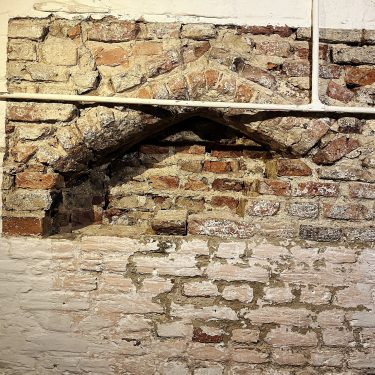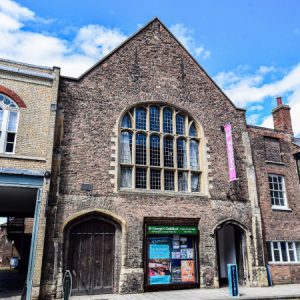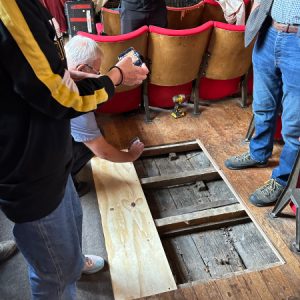
Has Historic Norfolk Theatre Discovered Shakespeare’s Dressing Room Door?
Archaeological work at St George’s Guildhall, the UK’s oldest working theatre, has revealed a 600-year-old doorway which may once have led to William Shakespeare’s dressing room.
Last year the King’s Lynn theatre created headlines around the world after identifying floorboards believed to have been part of the stage where Shakespeare once performed.
Now further archaeological investigations as part of a huge conservation project for the Guildhall have revealed another tantalising link to the Bard.
The Guildhall’s Creative Director Tim FitzHigham had long been intrigued by a strange shape in a wall on the theatre’s ground floor hidden behind two phases of plasterboards.
In collaboration with archaeologist Dr Jonathan Clark, specialist plaster remover Paul Wooles, the Borough of King’s Lynn and West Norfolk, and the National Trust, it was decided to investigate further.
The first notice board was removed, revealing a second notice board behind it, and then an 18th-century wall. As bricks from this wall were removed an extraordinary, much-earlier archway was revealed.
“It has got to be pre-1405 as the hall’s medieval roof is held up above it,” said Tim FitzHigham.
“Further exploratory work identified the arch as the door to what is believed to be the Guild Robing Room. This room was used by the highest level of Guild members to dress in their finery before feasting upstairs.
“The Guilds, akin to 1400s membership clubs, ceased using the hall, and the room likely took on the role of a dressing room or ‘tiring house’ for visiting actors,” he added.
During the Elizabethan period, the tiring house would have been bustling with actors changing and collecting props, often overseen by a prop master to ensure the safety of valuable items.
In Shakespeare’s time the Guildhall was used extensively by touring companies – Queen Elizabeth’s Men, a troupe of actors formed at the command of the Tudor Queen in 1583, performed there 10 times in the late 1500s.
In 1592-3 London’s theatres were closed because of another outbreak of plague and William Shakespeare and his company of actors were on tour in King’s Lynn in Norfolk.
“This is another mind-boggling discovery at the Guildhall,” said Tim. “We’ve got a door that would definitely have been here in the years we think Shakespeare played here and, in all likelihood, was the door to a room where the players changed and stored props.
“It is simply staggering that again a slight hunch or weird shape in the wall has turned out to be something frankly extraordinary,” he added.
Dr Clark’s research has also almost certainly pinpointed the location of a stairway that once connected to the tiring house, emphasising the historical significance of the find.
“This 15th century doorway appears to have provided access to a medium sized low status room, and not to have ever had a door closing up the arch; it may have been made private with a simple hanging when required,” he said.
“It is the type of room where travelling groups of players might change due to its location within the Guildhall. It would have given them a private space where they could put things, change and then travel up the staircase to appear on the first floor in their costume,” he added.
St George’s Guildhall is Grade 1 listed and is the largest intact medieval guild hall in England.
The St George’s Guildhall project, which is supported by funding from the Towns Fund, will see the refurbishment of Britain’s oldest working theatre and the formation of a new creative hub on the site.
The works will create an inspiring, welcoming, and historic space for arts, entertainment, creativity and learning with something for everyone to enjoy and experience.
Issued on behalf of St George’s Guildhall by Destination. For more information, please contact Drew Cunliffe drew.cunliffe@wearedestination.com.


About St George’s Guildhall
The Guildhall is managed by the Borough Council of King’s Lynn and West Norfolk and supports a year-round programme of theatre, dance, music, lectures and film.
Town Investment Plan
In 2021, King’s Lynn was awarded £25M in funding from the Towns Fund.
The Town Investment Plan was developed to access the funding and includes projects around three themes:
Innovative, growing business and skilled workforce;
Sustainable connected town;
Repurposed town centre.
The King’s Lynn Town Deal funding and projects are overseen by the King’s Lynn Town Deal Board which brings together a diverse range of individuals representing the community, businesses, and local authorities.
Their collaborative approach and expertise provide stability for the long term vision for the town, a town in which people feel engaged in town developments and have both the skills and opportunities to flourish, enabling our businesses and communities to thrive.
The board is made up of representatives from all tiers of local authority, the Member of Parliament, local businesses, the Local Enterprise Partnership, Business Improvement District, Queen Elizabeth Hospital, College of West Anglia, and the community.